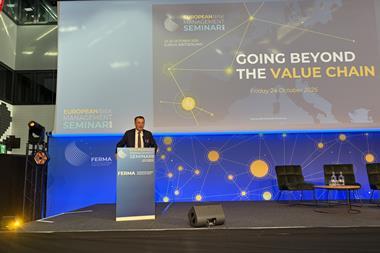Stephen Carver, a managing partner at ALS, used the history of NASA’s space programme to illustrate the pressures and poor decisions that led to the Challenger and Columbia disasters
‘If you don’t take risks, you achieve nothing,’ said Stephen Carver, a managing partner at ALS. In his plenary speech yesterday, Carver opened by saying that risk managers should consider:
• Sustainability vs short-term
• Values-driven vs controls-led
• People vs processes
• IQ vs EQ.
Carver used the history of NASA’s space programme to illustrate the pressures and poor decisions that led to the Challenger and Columbia disasters. With a huge budget designed to ensure that the US won the space race to the moon, NASA increasingly outsourced to keep the project on track. While the most important deliverable for getting men to the moon should have been to get them back safely,
Richard Nixon’s motivator was to plant the American flag on the lunar landscape and beat Communist rivals. With the feat accomplished, NASA turned its attention to Mars. But the combination of pressures to reduce cost, complacency engendered by past success, the isolationist nature of the Marshall centre which controlled engineering and the autocratic nature of its chief Bill Lucas meant that a disaster was inevitable.
Despite known problems with vital parts that were exacerbated by low temperatures, NASA went ahead with its space shuttle launches. NASA was under such great pressure to complete its programme that risk management was forgotten, said Carver.
Disaster came in January 1986 when, after three cancellations, the, Challenger, with Christa McAuliffe, first ordinary US citizen in space aboard, launched. The temperature was 24 degrees lower than the lowest launch temperature so far, and sub-contractors Morton Thiokil International had called for a launch abort. However, they had been over-ridden and the Challenger and its crew were lost.For a while the lessons were learnt, and NASA became at the forefront of risk assessment, explained Carver.
However, after a further 87 smooth launches, complacency set in again. Communication became poor, a checklist mentality prevailed, and standards slipped. ‘Disasters happen when people have forgotten about the last disaster,’ warned Carver. Perhaps the loss of the Columbia and its crew in 2003 was even more inexcusable.
NASA ignored reports of wing damage occurring during take-off, despite knowing what the effects of this would be when the Columbia reentered the atmosphere. So the feasible option of rescuing the astronauts in space was never considered. Carver said that both these disasters were preventable.
Before they occurred, some of those in control were 100% certain of the fatal outcome. NASA has now improved its risk management and resumed its space programmer. The astronauts and their pilots now make the final decision on whether a launch goes ahead – although Carver said that the last question one pilot asked his crew before pushing the launch button was ‘Do you feel lucky?’ Carver concluded by wishing the FERMA risk managers luck in their roles.




















No comments yet